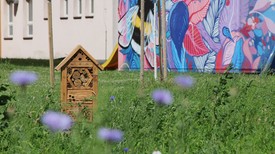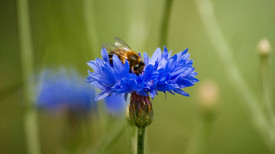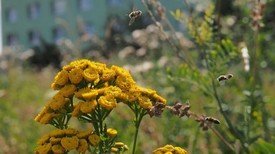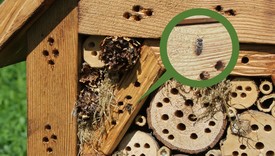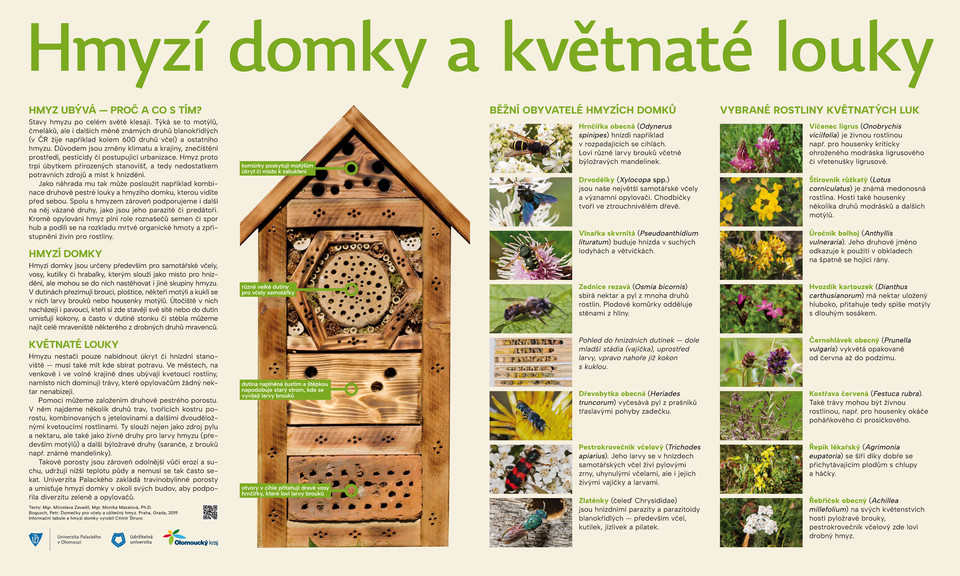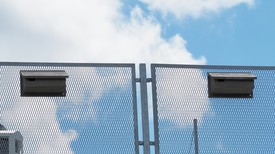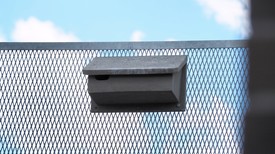Support for Biodiversity
Flower Meadows and Insect Hotels
Short-mown urban lawns offer almost no shelter or food for animals, and during prolonged heat and drought, they may partially wither and die. However, urban spaces can still serve as refuges for many important insect species—this is evidenced by flower meadows and insect hotels established in several locations in Olomouc thanks to the Sustainable University.
For Whom?
- For insects and other invertebrates: habitat for living, hiding, feeding, mating, nesting, and further development.
- For birds: insects provide food for many insectivorous birds, and seed-eating birds feed on the seeds of grasses, thistles, and other plants.
- For other vertebrates: taller vegetation provides cover and food for, e.g., lizards, slow worms, rodents, and insectivores from shrews to hedgehogs.
- For people: a place to observe life, one of the recommended stops in the Uni t(r)ips Guide.
Why?
Changes in landscape, climate, and pollution or eutrophication are among the main causes of the global decline in insect populations. One way to support abundant and species-rich insect communities is the establishment of flower meadows, which also increase species, functional, and structural diversity of vegetation. Urban greenery is often made up of uniform, frequently mown grasslands dominated by grasses that do not provide insects with nectar. In contrast, flower meadows created with the right seed mix are a source of pollen, nectar, and food plants for both larvae and adults of herbivorous insects. Besides supporting biodiversity, other benefits include water retention in the landscape and improved soil conditions. These stands are resistant to drought and erosion and remain green even in summer. They also keep soil temperatures lower and do not require frequent mowing.
Insect Hotels
Insect hotels provide shelter and nesting sites for insects and come from local production in the Valašsko region.
The structure of each part of the insect hotel offers space for adult day butterflies and their pupating caterpillars, diverse natural cavities for beetles and solitary bees, or drilled holes in bricks for mason wasps.
Map of flower meadows and insect hotels
Swift and Bat Boxes
Installing boxes for swifts and bats on buildings helps compensate for the loss of natural shelters, which these species lose through renovations and insulation of buildings. Both swifts and bats are protected animals and play key roles in the urban ecosystem. The boxes provide them with safe nesting places and help sustain biological diversity in cities.
Sustainable University, together with the Department of Development and Construction and the Czech Society for Ornithology and the Czech Bat Conservation Society, has installed boxes, for example, on the new building of the UP Archives and the Envelopa Hub. The latter also features a green facade and protective glass markings to prevent bird collisions, as it is located near the main flow of the Morava River, intersecting the flight corridor of several bird species.
Would you also like to support swifts and bats in your area? Get inspired:
- Helping Swifts (Czech Society for Ornithology)
- Bat protection in buildings – ČESON My Neighbor Bat project, more about bats, bat boxes, and installation
- Suitable boxes for both groups can be bought at the ČSO Zelená domácnost charity e-shop
Bird Collision Prevention Markings
Protective window markings help prevent birds from colliding with the glass surfaces of university buildings. The Czech Society for Ornithology estimates that around 1 million birds die each year in the Czech Republic due to glass collisions. They note that a single predatory bird silhouette on glass is ineffective, recommending a regular pattern of stickers placed about 10 cm apart.
To ensure new buildings at Palacký University meet sustainable development principles, the Methodological Guide for New UP Buildings has been created. It covers various criteria from urbanism and the impact on public space, environment, and biodiversity (including the risk of bird collisions) to water management, energy, waste, and long-term maintenance and sustainability.
More can be found on the ČSO page Birds and Glass. Suitable stickers (including UV variants that are nearly invisible to humans) are available at the ČSO Zelená domácnost e-shop.
